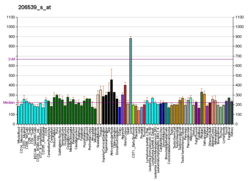Top Qs
Timeline
Chat
Perspective
CYP4F12
Protein-coding gene in the species Homo sapiens From Wikipedia, the free encyclopedia
Remove ads
Cytochrome P450 4F12 is a protein that, in humans, is encoded by the CYP4F12 gene.[5][6]
Remove ads
Gene family
The CYP4F12 gene encodes a member of the cytochrome P450 superfamily of enzymes. It is located within a cluster of P450 genes on chromosome 19.[6][7] Cytochrome P450 proteins are monooxygenases that catalyze a wide array of reactions involved in drug metabolism and in the synthesis of cholesterol, steroids, and other lipids.
Expression and localization
CYP4F12 is thought to localize to the endoplasmic reticulum. It is expressed in the liver and throughout the gastrointestinal tract. The enzyme is known to metabolize the antihistamines ebastine and terfenadine, suggesting it may play a role in the metabolism of these and other drugs.[7][8]
Substrate specificity
When expressed in yeast, CYP4F12 oxidizes arachidonic acid by hydroxylating carbon 18 or 19 to form 18-HETE or 19-HETE, respectively, though the physiological significance of this activity remains unclear. It also metabolizes prostaglandin H2 (PGH2) and PGH1 to their 19-hydroxyl analogs, potentially reducing their biological activity.[8]
In addition to monooxygenase activity, CYP4F12 also functions as an epoxygenase. It metabolizes docosahexaenoic acid (DHA) and eicosapentaenoic acid (EPA), two omega-3 fatty acids, to produce epoxide derivatives: DHA → 19R,20S- and 19S,20R-epoxydocosapentaenoic acids (19,20-EDP) EPA → 17R,18S- and 17S,18R-epoxyeicosatetraenoic acids (17,18-EEQ).[9]
Function
19-HETE, one of CYP4F12’s products, inhibits the activity of 20-HETE, a pro-inflammatory and vasoconstrictive signaling molecule. However, the in vivo importance of this inhibition has yet to be confirmed (see 20-Hydroxyeicosatetraenoic acid). EDPs (see Epoxydocosapentaenoic acid) and EEQs (see epoxyeicosatetraenoic acid) exhibit a wide range of biological activities in animal models and in vitro systems:
- Lower blood pressure[10] and pain perception[11][12]
- Suppress inflammation[11]
- Inhibit angiogenesis, endothelial cell migration and proliferation][11]
- Inhibit growth and metastasis of breast and prostate cancer cell lines][11]
These findings suggest that EDPs and EEQs may contribute to the beneficial effects of dietary omega-3 fatty acids such as DHA and EPA in humans.[10][12][13][14] These metabolites are short-lived and are rapidly inactivated by epoxide hydrolases, particularly soluble epoxide hydrolase, limiting their action to local environments.
Remove ads
Comparison with CYP4F8
CYP4F12 shares similar enzymatic activity with CYP4F8, particularly in fatty acid metabolism and epoxide formation. However, neither enzyme is considered a major contributor to these processes in humans, although they may play important roles in tissues where they are highly expressed.[8]
References
External links
Further reading
Wikiwand - on
Seamless Wikipedia browsing. On steroids.
Remove ads





